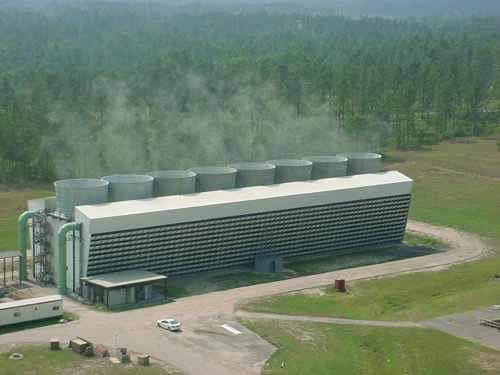In Part 4, we are focusing on structural analysis and collapse mitigation. Industrial facilities are often open-framed structures exposed to the elements. Different process units create their own micro-environments, which cause damage to the structures in unique ways. Two examples that will be explored in this article are: cooling towers that discharge water vapor continuously, and fluid catalytic cracking (FCC) units that operate at around 900° F.
Cooling towers that discharge water vapor continuously, and fluid catalytic cracking (FCC) units that operate at around 900° F.
Cooling Towers
Brindley Engineering recently was called to assess a large, 12-cell tower in Canada that experienced a partial structural collapse of two cells due to excessive ice-build up within the cells and a weakened support structure due to rot of the wood framing system caused from continuous wetting. Members from our Structural Team mobilized to site to quickly assess the structure, build RISA™ structural models of the framing system, and assess the utilization of the remaining members in their current, in-situ condition. To keep this vital piece of equipment in service, the team developed a two-part plan starting with temporary shoring to keep the structure stable until the weather improved, and permanent repairs for when the tower could be shut down during a plant-wide outage. The team had to contend with a dynamic situation and high loads from both the environment and 42” diameter water lines, making this a challenging structural engineering problem to solve.
Fluid Catalytic CrackingUnits
The center of mass and center of surface area for these units is towards the top of these structures, creating significant wind and seismic loads. Further, these units operate around 900° and the internal process equipment and piping can grow more than 6” vertically, creating challenges for structural engineering in supporting these excessive and moving loads.
Brindley Engineering has conducted structural assessments of dozens of these structures. One particularly challenging unit in the Midwest was experiencing excessive corrosion on some support decks due to being down-wind of cooling towers. To prevent these decks from collapsing, steel had to be replaced systematically from sound material above and below the deteriorated decks, all while maintaining support for the equipment and piping in operation and accounting for the possibility of an emergency shutdown.
Our team developed numerous models of the structure under different loading and operating scenarios and developed movable supports and innovative shorting to pick up loads in excess of 50,000 lbs. As repairs were executed, the support locations had to move, creating significant constructability challenges to overcome.
Experience in load assessments, structural modelling, and steel design were the base requirements of the engineers involved with these assessments, similar to the skills required of structural engineers in the building and bridge industries. We are accustomed to training engineers from the bridge and building industries to solve unique problems in process facilities. In Part 5, the final part in this series, we’ll explore a unique constructability challenge we faced in a chemical process facility.
We are looking to expand our structural department. Want a rewarding structural engineering career?
- Click here to read Part 1 of this series.
- Click here to read Part 2 of this series.
- Click here to read Part 3 of this series.
- Click here to read Part 5 of this series.



0 Comments